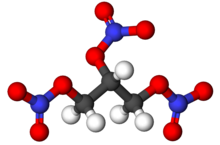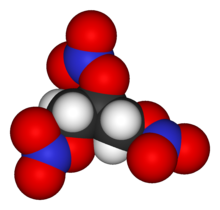
Back Nitrogliserien AF نيتروغليسرين Arabic نيتروجليسرين ARZ Nitroqliserin AZ نیتروقلیسرین AZB Нітрагліцэрын BE Нитроглицерин Bulgarian নাইট্রোগ্লিসারিন Bengali/Bangla Nitroglicerin BS Nitroglicerina Catalan

| |

| |

| |
| Names | |
|---|---|
| Preferred IUPAC name
Propane-1,2,3-triyl trinitrate | |
Other names
| |
| Identifiers | |
3D model (JSmol)
|
|
| 1802063 | |
| ChEBI | |
| ChEMBL | |
| ChemSpider | |
| DrugBank | |
| ECHA InfoCard | 100.000.219 |
| EC Number |
|
| 165859 | |
| KEGG | |
| MeSH | Nitroglycerin |
PubChem CID
|
|
| UNII | |
| UN number | 0143, 0144, 1204, 3064, 3319 |
CompTox Dashboard (EPA)
|
|
| |
| |
| Properties | |
| C3H5N3O9 | |
| Molar mass | 227.085 g·mol−1 |
| Appearance | Colorless or pale yellow, oily liquid or tetraclinic/orthorhombic crystal |
| Density | 1.5931 g/cm−3 |
| Melting point | 12.8 °C (55.0 °F; 285.9 K) |
| Boiling point | 218 °C (424 °F; 491 K) Explodes |
| Slightly[1] | |
| Solubility | acetone, diethyl ether, benzene, toluene, ethanol[1] |
| log P | 2.154 |
| Structure | |
| |
| |
| Explosive data | |
| Shock sensitivity | High |
| Friction sensitivity | High |
| Detonation velocity | 7,820 m/s |
| RE factor | 1.50 |
| Thermochemistry | |
Std enthalpy of
formation (ΔfH⦵298) |
−370 kJ⋅mol−1 |
Std enthalpy of
combustion (ΔcH⦵298) |
−1.529 MJ⋅mol−1 |
| Pharmacology | |
| C01DA02 (WHO) C05AE01 (WHO) | |
| Intravenous, by mouth, under the tongue, topical | |
| Pharmacokinetics: | |
| <1% | |
| Liver | |
| 3 min | |
| Legal status |
|
| Hazards | |
| Occupational safety and health (OHS/OSH): | |
Main hazards
|
Explosive, toxic |
| GHS labelling: | |
   
| |
| Danger | |
| H202, H205, H241, H301, H311, H331, H370 | |
| P210, P243, P250, P260, P264, P270, P271, P280, P302+P352, P410 | |
| NFPA 704 (fire diamond) | |
| NIOSH (US health exposure limits): | |
PEL (Permissible)
|
C 0.2 ppm (2 mg/m3) [skin][2] |
Except where otherwise noted, data are given for materials in their standard state (at 25 °C [77 °F], 100 kPa).
| |
Nitroglycerin (NG) (alternative spelling of nitroglycerine), also known as trinitroglycerol (TNG), nitro, glyceryl trinitrate (GTN), or 1,2,3-trinitroxypropane, is a dense, colorless or pale yellow, oily, explosive liquid most commonly produced by nitrating glycerol with white fuming nitric acid under conditions appropriate to the formation of the nitric acid ester. Chemically, the substance is a nitrate ester rather than a nitro compound, but the traditional name is retained. Discovered in 1846 by Ascanio Sobrero,[4] nitroglycerin has been used as an active ingredient in the manufacture of explosives, namely dynamite, and as such it is employed in the construction, demolition, and mining industries. It is combined with nitrocellulose to form double-based smokeless powder, used as a propellant in artillery and firearms since the 1880s.
As is the case for many other explosives, nitroglycerin becomes more and more prone to exploding (i.e. spontaneous decomposition) as the temperature is increased. Upon exposure to heat above 218 °C at sea-level atmospheric pressure, nitroglycerin becomes extremely unstable and tends to explode. When placed in vacuum, it has an autoignition temperature of 270 °C instead.[5] With a melting point of 12.8 °C, the chemical is almost always encountered as a thick and viscous fluid, changing to a crystalline solid when frozen.[5][6] Although the pure compound itself is colorless, in practice the presence of nitric oxide impurities left over during production tends to give it a slight yellowish tint.
Due to its high boiling point and consequently low vapor pressure (0.00026 mmHg at 20 °C),[5] pure nitroglycerin has practically no odor at room temperature, with a sweet and burning taste when ingested. Unintentional detonation may ensue when dropped, shaken, lit on fire, rapidly heated, exposed to sunlight and ozone, subjected to sparks and electrical discharges, or roughly handled.[7] Its sensitivity to exploding is responsible for numerous devastating industrial accidents throughout its history. The chemical's characteristic reactivity may be reduced through the addition of desensitizing agents, which makes it less likely to explode. Clay (diatomaceous earth) is an example of such an agent, forming dynamite, a much more easily handled composition. Addition of other desensitizing agents give birth to the various formulations of dynamite.
Nitroglycerin has been used for over 130 years in medicine as a potent vasodilator (causing dilation of the vascular system) to treat heart conditions, such as angina pectoris and chronic heart failure. Though it was previously known that these beneficial effects are due to nitroglycerin being converted to nitric oxide, a potent venodilator, the enzyme for this conversion was only discovered to be mitochondrial aldehyde dehydrogenase (ALDH2) in 2002.[8] Nitroglycerin is available in sublingual tablets, sprays, ointments, and patches.[9]
- ^ a b "Occupational Safety and Health Guideline for Nitroglycerin". Archived from the original on 16 May 2013. Retrieved 19 October 2016.
- ^ NIOSH Pocket Guide to Chemical Hazards. "#0456". National Institute for Occupational Safety and Health (NIOSH).
- ^ "Hazard Rating Information for NFPA Fire Diamonds". Archived from the original on 17 February 2015.
- ^ "Ascanio Sobrero". Oxford Reference. Retrieved 16 July 2024.
- ^ a b c "Occupational Safety and Health Guideline for Nitroglycerin". 16 May 2013. Archived from the original on 16 May 2013. Retrieved 9 July 2024.
- ^ Haynes, W. M. CRC Handbook of Chemistry and Physics (97th ed.). CRC Press. pp. 3–540.
- ^ "Nitroglycerin, desensitized, liquid". CAMEO Chemicals | NOAA. Archived from the original on 26 August 2023. Retrieved 9 July 2024.
- ^ Chen, Z.; Foster, M. W.; Zhang, J.; Mao, L.; Rockman, H. A.; Kawamoto, T.; Kitagawa, K.; Nakayama, K. I.; Hess, D. T.; Stamler, J. S. (2005). "An essential role for mitochondrial aldehyde dehydrogenase in nitroglycerin bioactivation". Proceedings of the National Academy of Sciences. 102 (34): 12159–12164. Bibcode:2005PNAS..10212159C. doi:10.1073/pnas.0503723102. PMC 1189320. PMID 16103363.
- ^ "Unknown, behind paywall, archived". Archived from the original on 10 May 2017. Retrieved 14 April 2018.
